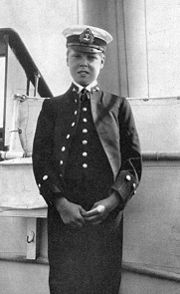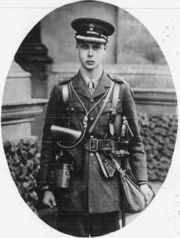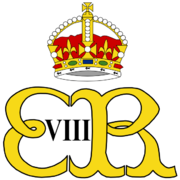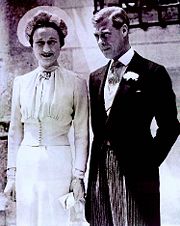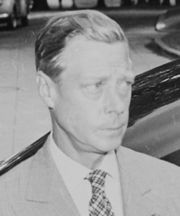Edward VIII of the United Kingdom
2008/9 Schools Wikipedia Selection. Related subjects: British History Post 1900; Monarchs of Great Britain
| Edward VIII | |
|---|---|
| King of Great Britain, Ireland and the British Dominions beyond the Seas, Emperor of India (more...) |
|
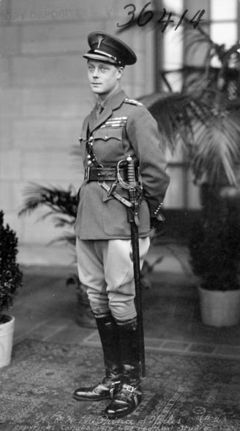 |
|
| Edward as Prince of Wales, 1919 | |
| Reign | 20 January – 11 December 1936 |
| Predecessor | George V |
| Successor | George VI |
| Spouse | Wallis Warfield (post-abdication) |
| Full name | |
| Edward Albert Christian George Andrew Patrick David | |
| Titles and styles | |
| HRH The Duke of Windsor HM The King HRH The Prince of Wales HRH The Duke of Cornwall HRH Prince Edward of Wales HRH Prince Edward of Cornwall and York HRH Prince Edward of York HH Prince Edward of York |
|
| Royal house | House of Windsor |
| Royal anthem | God Save the King |
| Father | George V |
| Mother | Mary of Teck |
| Born | 23 June 1894 White Lodge, Richmond, London, England |
| Baptised | 16 July, 1894 White Lodge, Richmond, London, England |
| Died | 28 May 1972 (aged 77) Paris, France |
| Burial | 5 June, 1972 Frogmore, Berkshire, England |
Edward VIII (Edward Albert Christian George Andrew Patrick David; later The Duke of Windsor; 23 June 1894 – 28 May 1972) was King of Great Britain, Ireland, the British Dominions beyond the Seas, and Emperor of India from the death of his father, George V (1910–36), on 20 January 1936, until his abdication on 11 December 1936. He was the second monarch of the House of Windsor, his father having changed the name of the Royal house from Saxe-Coburg-Gotha in 1917.
Before his accession to the throne, Edward VIII held the titles of Prince Edward of York, Prince Edward of Cornwall and York, Duke of Cornwall, Duke of Rothesay, and Prince of Wales (all with the style Royal Highness). As a young man he served in World War I, undertook several foreign tours on behalf of his father, and was associated with a succession of older married women.
Only months into his reign, Edward forced a constitutional crisis by proposing marriage to the American divorcée Wallis Simpson. Although legally Edward could have married Mrs. Simpson and remained king, his various prime ministers opposed the marriage, arguing that the people would never accept her as queen. Edward knew that the ministry of British Prime Minister Stanley Baldwin would resign if the marriage went ahead; this could have dragged the King into a general election thus ruining irreparably his status as a politically neutral constitutional monarch. Rather than give up Mrs. Simpson, Edward chose to abdicate, making him the only monarch of Britain, and indeed any Commonwealth Realm, to have voluntarily relinquished the throne. He is one of the shortest-reigning monarchs in British history, and was never crowned.
After his abdication he reverted to the style of a son of the sovereign, The Prince Edward, and was created Duke of Windsor on 8 March 1937. During World War II he was at first stationed with the British Military Mission to France, but after private accusations that he held pro-Nazi sympathies, was moved to the Bahamas as Governor and Commander-in-Chief. After the war he was never given another official appointment and spent the remainder of his life in retirement.
Early life
Edward VIII was born on 23 June 1894, at White Lodge in Richmond, England. He was the eldest son of The Duke of York (later King George V), and The Duchess of York (formerly Princess Victoria Mary of Teck). His father was the second son of The Prince of Wales (later King Edward VII) and The Princess of Wales (formerly Princess Alexandra of Denmark). His mother was the eldest daughter of The Duke of Teck and The Duchess of Teck (formerly Princess Mary Adelaide of Cambridge). As a great grandson of Queen Victoria in the male line, Edward was styled His Highness Prince Edward of York at his birth.
He was baptised in the Green Drawing Room of White Lodge on 16 July 1894, by Edward White Benson, Archbishop of Canterbury. Edward VIII was named after his late uncle, who was known to his family as "Eddy" or Edward, and his great-grandfather King Christian IX of Denmark. The name Albert was included at the behest of Queen Victoria. His last four names – George, Andrew, Patrick and David – came from the Patron Saints of England, Scotland, Ireland and Wales. The Prince was nevertheless, for the rest of his life, known to his family and close friends by his last given name, David.
Edward's parents, The Duke and Duchess of York, were often removed from their children's upbringing, like other upper-class English parents of the day. Edward and his younger brother Albert were abused by one of the royal nannies. The nanny would pinch Edward before he was due to be presented to his parents. His subsequent crying and wailing would lead the Duke and Duchess to send Edward and the nanny away. His father, though a harsh disciplinarian, was demonstrably affectionate and his mother displayed a frolicksome side when dealing with her children that belies her austere public image. She was amused by the children making tadpoles on toast for their French master, and encouraged them to confide matters in her which it would have provoked their father to know.
Prince of Wales
Edward automatically became Duke of Cornwall and Duke of Rothesay when his father, George V, ascended the throne on 6 May 1910. The new King created him Prince of Wales and Earl of Chester on 23 June 1910, and officially invested him as such in a special ceremony at Caernarfon Castle on 13 July 1911. For the first time since 1616, and the evidence for that ceremony is thin, the investiture took place in Wales at the instigation of the Welsh politician David Lloyd George, Constable of the Castle, who at that time held the position of Chancellor of the Exchequer in the Liberal government. Lloyd George invented a rather fanciful ceremony which took the form of a Welsh pageant, and coached Edward to utter some sentences in Welsh.
Military career
When the First World War (1914–18) broke out, Edward had reached the minimum age for active service and was keen to participate. He had joined the army, serving with the Grenadier Guards, in June 1914, and although Edward was willing to serve on the front lines, the Secretary of State for War, Lord Kitchener, refused to allow it, citing the immense harm that would occur if the heir to the throne was captured.
Despite this, Edward witnessed trench warfare firsthand and attempted to visit the front line as often as he could, for which he was awarded the Military Cross in 1916. His role in the war, although limited, led to his great popularity among veterans of the conflict. As of 1911 he was also a Midshipman in the Royal Navy, making Lieutenant in 1913. Edward undertook his first military flight in 1918 and later gained his pilot's licence. On his succession he became Admiral of the Fleet in the Navy, Field Marshal in the Army, and Marshal of the Royal Air Force.
Royal duties
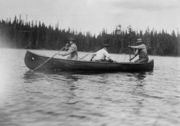
Throughout the 1920s Edward, as Prince of Wales, represented his father, King George V, at home and abroad on many occasions. He took a particular interest in visiting the poverty stricken areas of the country, and undertook 16 tours to various parts of the Empire between 1919 and 1935, in the process acquiring the Bedingfield ranch, near Pekisko, Canada. In 1924, he donated the Prince of Wales Trophy to the National Hockey League. The trophy is currently presented to the Eastern Conference playoff champion, and from 1974 to 1993 the conference was known as the "Prince of Wales Conference".
His attitudes to many of the Empire's subjects and various foreign peoples, both during his career as Prince of Wales and later as Duke of Windsor, were little commented upon in their time but have soured his reputation since. He said of Indigenous Australians: "they are the most revolting form of living creatures I've ever seen!! They are the lowest known form of human beings & are the nearest thing to monkeys."
He soon became the 1920s version of a latter-day movie star. At the height of his popularity, he became the most photographed celebrity of his time and he set men's fashion.
Romances
In 1930, King George V gave Edward a home, Fort Belvedere, near Sunningdale, England. There, Edward had relationships with a series of married women including half-British half-American textile heiress Freda Dudley Ward, American film actress Mildred Harris, and Lady Furness (born Thelma Morgan), an American woman of part-Chilean ancestry, who introduced the Prince to fellow American Wallis Simpson. Mrs. Simpson had divorced her first husband in 1927 and had subsequently married Ernest Simpson, a half-British half-American businessman. Mrs. Simpson and the Prince of Wales, it is generally accepted, became lovers while Lady Furness travelled abroad, though Edward adamantly insisted to his father, the King, that he was not intimate with her and that it was not appropriate to describe her as his mistress.
| British Royalty |
|---|
| House of Windsor |
 |
| George V |
| Edward VIII |
| George VI |
| Mary, Princess Royal |
| Henry, Duke of Gloucester |
| George, Duke of Kent |
| Prince John |
| Edward VIII |
King George V was disappointed in Edward's failure to settle down in life and disgusted by his many affairs with married women. The King was reluctant to see Edward inherit the Crown, and was quoted as saying of Edward: "After I am dead, the boy will ruin himself in 12 months". He later said of his second son, Albert ("Bertie"), and granddaughter, Elizabeth, ("Lilibet"): "I pray to God that my eldest son Edward will never marry and have children, and that nothing will come between Bertie and Lilibet and the throne." Edward's relationship with Mrs. Simpson further weakened his poor relationship with his father. Although the King and Queen met Mrs. Simpson at Buckingham Palace in 1935, they later refused to receive her. But Edward had now fallen in love with Wallis and the couple grew ever closer.
Edward's affair with the American divorcée led to such grave concern that the couple were followed by members of the Metropolitan police Special Branch, to examine in secret the nature of their relationship. An undated report detailed a visit by the couple to an antique shop, where the proprietor later noted that: "the lady seemed to have POW [Prince of Wales] completely under her thumb." The prospect of having an American divorcée with a questionable past having such sway over the heir apparent caused some anxiety to government and establishment figures at the time.
Reign
King George V died on 20 January 1936, and Edward ascended the throne as King Edward VIII. The next day, he broke royal protocol by watching the proclamation of his own accession to the throne from a window of St. James's Palace in the company of the then still-married Mrs. Simpson. It was also at this time that Edward VIII became the first monarch of the Commonwealth Realms to fly in an aeroplane, when he flew from Sandringham to London for his Accession Council.
Edward caused unease in government circles with actions that were interpreted as interference in political matters. On visiting the depressed coal mining villages in South Wales the King’s observation that "something must be done" for the unemployed coal miners was seen as directly critical of the Government, though it has never been clear whether Edward had anything in particular in mind. Government ministers were also reluctant to send confidential documents and state papers to Fort Belvedere because it was clear that Edward was paying little attention to them and because of the perceived danger that Mrs. Simpson and other house guests might see them.
Edward's unorthodox approach to his role also extended to the currency which bore his image. He broke with the tradition that on coinage each successive monarch faced in the opposite direction to his or her predecessor. Edward insisted his left side was superior to his right, and that he face left (as his father had done). Only a handful of coins were actually struck before the abdication, and when George VI succeeded he also faced left, to maintain the tradition by suggesting that had any coins been minted featuring Edward's portrait, they would have shown him facing right.
On 16 July 1936 an attempt was made on Edward's life. An Irish malcontent, Jerome Brannigan (otherwise known as George Andrew McMahon) produced a loaded revolver as the King rode on horseback at Constitution Hill, near Buckingham Palace. Police spotted the gun and pounced on him; he was quickly arrested. At Brannigan's trial, he alleged that "a foreign power" had approached him to kill Edward, that he had informed MI5 of the plan, and that he was merely seeing the plan through to help MI5 catch the real culprits. The court rejected the claims and sent him to jail for a year. It is now thought that Brannigan had indeed been in contact with MI5 but the veracity of the remainder of his claims remains open.
By October it was becoming clear that the new King planned to marry Mrs. Simpson, especially when divorce proceedings between Mr. and Mrs. Simpson were brought at Ipswich Crown Court. Preparations for all contingencies were made, including the prospect of the coronation of King Edward and Queen Wallis. Because of the religious implications of any marriage, plans were made to hold a secular coronation ceremony not in the traditional religious location, Westminster Abbey, but in the Banqueting House in Whitehall.
Abdication
On 16 November 1936, Edward invited Prime Minister Stanley Baldwin to Buckingham Palace and expressed his desire to marry Wallis Simpson when she became free to re-marry. Baldwin informed the King that his subjects would deem the marriage morally unacceptable, largely because remarriage after divorce was opposed by the Church of England, and the people would not tolerate Wallis as Queen. As King, Edward held the role of Supreme Governor of the Church of England, and was expected by the clergy to support the Church's teachings.
Edward proposed an alternative solution of a morganatic marriage, in which Edward would remain King but Wallis would not become Queen. She would enjoy some lesser title instead, and any children they might have would not inherit the throne. This too was rejected by the British Cabinet as well as other Dominion governments, whose views were sought pursuant to the Statute of Westminster 1931, which provided in part that "any alteration in the law touching the Succession to the Throne or the Royal Style and Titles shall hereafter require the assent as well of the Parliaments of all the Dominions as of the Parliament of the United Kingdom." The Prime Ministers of Australia, Canada and South Africa made clear their opposition to the King marrying a divorcée; the Irish Free State expressed indifference and detachment and New Zealand, having never even heard of Mrs. Simpson before, vacillated in disbelief. Faced with this opposition, Edward at first responded that there were "not many people in Australia" and their opinion didn't matter.
The King informed Baldwin that he would abdicate if he could not marry her. Baldwin then presented Edward with three choices: give up the idea of marriage; marry Mrs. Simpson against his ministers' wishes; or abdicate. It was clear that Edward was not prepared to give up Mrs. Simpson. By marrying against the advice of his ministers, he would cause the government to resign, prompting a constitutional crisis. He chose to abdicate.
Edward duly signed the instruments of abdication at Fort Belvedere on 10 December 1936, in the presence of his three brothers, The Duke of York, The Duke of Gloucester and The Duke of Kent. The next day, he performed his last act as King when he gave royal assent to His Majesty's Declaration of Abdication Act 1936. As required by the Statute of Westminster, all the Dominions consented to the King's abdication, though the Irish Free State did not pass the External Relations Act, which included the abdication in its schedule, until 12 December. As a curiosity, legally, for one day Edward was King of the Irish Free State but not the rest of the British Empire.
On the night of 11 December 1936, Edward, now reverted to the title of Prince Edward, made a broadcast to the nation and the Empire, explaining his decision to abdicate. He famously said, "I have found it impossible to carry the heavy burden of responsibility and to discharge my duties as king as I would wish to do without the help and support of the woman I love."
After the broadcast, Edward departed the United Kingdom for Austria, though he was unable to join Mrs. Simpson until her divorce became absolute, several months later. His brother, Prince Albert, Duke of York succeeded to the throne as George VI, whose elder daughter, The Princess Elizabeth, became first in the line of succession, as the heiress presumptive.
Duke of Windsor
On 12 December 1936, at his Accession Privy Council, George VI announced he was to make his brother Duke of Windsor, and also re-admit him to the highest degrees of the various British Orders of Knighthood. He wanted this to be the first act of his reign, although the formal documents were not signed until 8 March of the following year. But during the interim, Edward was universally known as the Duke of Windsor. The King's decision to create Edward a royal duke ensured that he could neither stand for election to the House of Commons nor speak on political subjects in the House of Lords.
However, letters patent dated 27 May 1937, which re-conferred upon the Duke of Windsor the "title, style, or attribute of Royal Highness", specifically stated that "his wife and descendants, if any, shall not hold said title or attribute". Some British ministers advised that Edward had no need of it being conferred because he had not lost it, and further that Mrs. Simpson would automatically obtain the rank of wife of a prince with the style HRH; others maintained that he had lost all royal rank and should no longer carry any royal title or style as an abdicated King. On 14 April 1937, Attorney General Sir Donald Somervell submitted to Home Secretary Sir John Simon a memorandum summarising the views of Lord Advocate T. M. Cooper, Parliamentary Counsel Sir Granville Ram and himself, to the effect that:
- We incline to the view that on his abdication the Duke of Windsor could not have claimed the right to be described as a Royal Highness. In other words, no reasonable objection could have been taken if the King had decided that his exclusion from the lineal succession excluded him from the right to this title as conferred by the existing Letters Patent
- The question however has to be considered on the basis of the fact that, for reasons which are readily understandable, he with the express approval of His Majesty enjoys this title and has been referred to as a Royal Highness on a formal occasion and in formal documents. In the light of precedent it seems clear that the wife of a Royal Highness enjoys the same title unless some appropriate express step can be and is taken to deprive her of it.
- We came to the conclusion that the wife could not claim this right on any legal basis. The right to use this style or title, in our view, is within the prerogative of His Majesty and he has the power to regulate it by Letters Patent generally or in particular circumstances.
The Duke of Windsor married Mrs. Simpson, who had changed her name by deed poll to Wallis Warfield, in a private ceremony on 3 June 1937, at Chateau de Candé, near Tours, France. When the Church of England refused to sanction the union, a County Durham clergyman, the Reverend Robert Anderson Jardine (Vicar of St Paul's, Darlington), offered to perform the ceremony, and the Duke accepted. The new king, George VI, forbade members of the Royal Family to attend—Edward had particularly wanted Princes Henry and George (the Dukes of Gloucester and Kent) and Lord Louis Mountbatten (Earl Mountbatten of Burma after 1947) to be there—and this continued for many years to rankle with the Duke and Duchess of Windsor.
The denial of the style "HRH" to the Duchess of Windsor caused conflict, as did the financial settlement—the government declined to include the Duke or the Duchess on the Civil List and the Duke's allowance was paid personally by the King. But the Duke had compromised his position with the King by concealing the extent of his financial worth when they informally agreed on the amount of the sinecure the King would pay. Edward's worth had accumulated from the revenues of the Duchy of Cornwall paid to him as Prince of Wales and ordinarily at the disposal of an incoming king. This led to strained relations between the Duke of Windsor and the rest of the Royal Family for decades. Edward became embittered against his own mother, writing to her in 1939: "[your last letter] destroy[ed] the last vestige of feeling I had left for you...[and has] made further normal correspondence between us impossible." In the early days of George VI's reign the Duke telephoned daily, importuning for money and urging that the Duchess be granted the style of HRH, until the harassed King ordered that the calls not be put through.
The Duke had assumed that he would settle in Britain after a year or two of exile in France. However, King George VI (with the support of his mother Queen Mary and his wife Queen Elizabeth) threatened to cut off Edward's allowance if he returned to Britain without an invitation. The new King and Queen were also forced to pay Edward for Sandringham House and Balmoral Castle. These properties were Edward's personal property, inherited from his father, King George V, on his death, and thus did not automatically pass to George VI on abdication.
World War II
In 1937, the Duke and Duchess visited Germany, against the advice of the British government, and met Nazi leader Adolf Hitler at Berchtesgaden. The visit was much publicised by the German media. During the visit the Duke gave full Nazi salutes. The Austrian ambassador, who was also a cousin and friend of George V, believed that Edward favoured German fascism as a bulwark against communism, and even that he initially favoured an alliance with Germany. Edward's experience of "the unending scenes of horror" during World War I led him to support appeasement. Hitler considered Edward to be friendly towards Nazi Germany, saying "His abdication was a severe loss for us."
The couple settled in France. On the outbreak of World War II in September 1939, they were brought back to Britain by Lord Mountbatten in HMS Kelly, and the Duke, already an honorary Field Marshal, was gazetted a Major-General attached to the British Military Mission in France. In February 1940, the German Minister in The Hague, Count Julius von Zech-Burkersroda, claimed that the Duke had leaked the Allied war plans for the defence of Belgium. When Germany invaded the north of France in May 1940, the Windsors fled south, first to Biarritz, then in June to Spain. In July the pair moved to Lisbon, Portugal, where they lived at first in the home of a banker with German contacts. During the occupation of France, the Duke asked the German forces to place guards at his Paris and Riviera homes: they did so. A "defeatist" interview with the Duke that was widely distributed may have served as the last straw for the British government: the Prime Minister Winston Churchill threatened the Duke with a court-martial if he did not return to British soil. In August, a British warship dispatched the pair to the Bahamas, where in the view of Winston Churchill the Duke could do least damage to the British war effort.
The Duke of Windsor was installed as Governor. He did not enjoy the position, and referred to the islands as "a third-class British colony". The British Foreign Office strenuously objected when the pair planned to tour aboard a yacht belonging to a Swedish magnate, Axel Wenner-Gren, whom American intelligence wrongly believed to be a close friend of Nazi leader Hermann Göring. However, the Duke was praised for his efforts to combat poverty on the island nation, although he was as contemptuous of the Bahamians as he was of most non-white peoples of the Empire. He said of Étienne Dupuch, the editor of the Nassau Daily Tribune: "It must be remembered that Dupuch is more than half Negro, and due to the peculiar mentality of this Race, they seem unable to rise to prominence without losing their equilibrium." He was praised, even by Dupuch, for his resolution of civil unrest over low wages in Nassau in 1942, even though he blamed the trouble on communist agitators and draft-dodging Jews. He held the post until the end of World War II in 1945.
Many historians have suggested that Hitler was prepared to reinstate Edward as King in the hope of establishing a fascist Britain. It is widely believed that the Duke (and especially the Duchess) sympathised with fascism before and during World War II, and had to remain in the Bahamas to minimise their opportunities to act on those feelings. In 1940 he said: "In the past 10 years Germany has totally reorganized the order of its society...Countries which were unwilling to accept such a reorganization of society and its concomitant sacrifices should direct their policies accordingly." Lord Caldecote wrote to Winston Churchill just before the couple were sent to the Bahamas, "[the Duke] is well-known to be pro-Nazi and he may become a centre of intrigue." The latter, but not the former, part of this assessment is corroborated by German operations designed to use the Duke. The Allies became sufficiently disturbed by the German plots that President Roosevelt ordered covert surveillance of the Duke and Duchess when they visited Palm Beach, Florida, in April 1941. The former Duke of Württemberg (then a monk in an American monastery) had convinced the Federal Bureau of Investigation that the Duchess had been sleeping with the German ambassador in London, Joachim von Ribbentrop, had remained in constant contact with him, and had continued to leak secrets.
Some authors have claimed that Anthony Blunt, an MI5 agent, acting on orders from the British Royal Family, made a successful secret trip to defeated Germany as the war was ending in order to retrieve sensitive letters between the Duke of Windsor and Adolf Hitler and other leading Nazis from Schloss Friedrichshof, Kronberg im Taunus. What is certain is that George VI sent the Royal Librarian, Owen Morshead, accompanied by Blunt, then working part-time in the Royal library as well as for British intelligence, to Kronberg in March 1945 to secure papers relating to Victoria, Princess Royal. Part of the castle's archive, including surviving letters between Victoria, Princess Royal, and her mother, Queen Victoria, as well as other valuables were stolen by looters, some of which were only later recovered in Chicago after the war. The papers rescued by Morshead and Blunt, and those returned by the American authorities from Chicago, were deposited in the Royal Archives.
After the war, the Duke admitted in his memoirs that he admired the Germans, but he denied being pro-Nazi. Of Hitler he wrote: "[the] Führer struck me as a somewhat ridiculous figure, with his theatrical posturings and his bombastic pretensions."
Later life
The couple returned to France and spent the remainder of their lives essentially in retirement as the Duke never occupied another official role after his wartime governorship of the Bahamas. The Duke's allowance was supplemented by government favours and illegal currency trading. The City of Paris provided the Duke with a house at 4 rue du Champ d'Entraînement, on the Neuilly-sur-Seine side of the Bois de Boulogne, for a nominal rent. The French government exempted him from paying income tax, and the couple were able to buy goods duty-free through the British embassy and the military commissary. In 1951, the Duke produced a ghost-written memoir, A King's Story, in which he makes no secret of his disagreement with liberal politics. The royalties from the book added to their income. Nine years later, he penned a relatively unknown book, A Family Album, chiefly about the fashion and habits of the Royal Family throughout his life, from the time of Queen Victoria through his grandfather and father, and his own tastes.
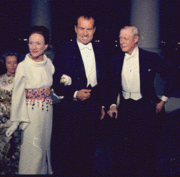
The Duke and Duchess effectively took on the role of minor celebrities and were regarded as part of café society for a time in the 1950s and 1960s. They hosted parties and shuttled between Paris and New York; many of those who met the Windsors socially, including Gore Vidal, reported on the vacuity of the Duke's conversation. In 1955, they visited President Dwight D. Eisenhower at the White House. The couple appeared on Edward R. Murrow's television interview show Person to Person in 1956, and a 50-minute BBC television interview in 1970. That year, they were invited as guests of honour to a dinner at the White House by President Richard Nixon in repayment for their having entertained Nixon in Paris during the mid-1960s when his political fortunes were low.
The Royal Family never fully accepted the Duchess; Queen Mary refused to receive her formally. However, the Duke sometimes met with his mother and brother, King George, and attended George's funeral. Queen Mary maintained her anger with Edward and her indignation over his marriage to Wallis: "To give up all this for that," she said. In 1965, the Duke and Duchess returned to London, England. They were visited by the Queen, Princess Marina, Duchess of Kent and the Princess Royal. A week later, the Princess Royal died, and they attended her memorial service. In 1967, they joined the Royal Family for the centenary of Queen Mary's birth. The last royal ceremony the Duke attended was the funeral of Princess Marina in 1968.
In the late 1960s, the Duke's health deteriorated. Queen Elizabeth visited the Windsors in 1972 while on a state visit to France; however, only the Duchess appeared with the royal party for a photocall. On 28 May of that year the Duke, who was a smoker from an early age, died at his home in Paris from throat cancer. His body was returned to Britain, lying in state at St George's Chapel at Windsor Castle; an unexpectedly large number of people filed by the coffin. The funeral service was held in the chapel on 5 June in the presence of the Queen, the Royal Family, and the Duchess of Windsor, and the coffin was buried in the Royal Burial Grounds behind the Royal Mausoleum of Queen Victoria and Prince Albert at Frogmore. The Duchess stayed at Buckingham Palace during her visit. Increasingly senile and frail, the Duchess died 14 years later, and was buried alongside her husband simply as "Wallis, Duchess of Windsor".
Titles, styles, honours and arms
| Monarchical Styles of King Edward VIII of the United Kingdom |
|
 |
|
| Reference style | His Majesty |
|---|---|
| Spoken style | Your Majesty |
| Alternative style | Sir |
Titles and styles
- 16 July 1894 – 28 May 1898: His Highness Prince Edward of York
- 28 May 1898 – 22 January 1901: His Royal Highness Prince Edward of York
- 22 January 1901 – 9 November 1901: His Royal Highness Prince Edward of Cornwall and York
- 9 November 1901 – 6 May 1910: His Royal Highness Prince Edward of Wales
- 6 May 1910 – 23 June 1910: His Royal Highness The Duke of Cornwall
- 23 June 1910 – 20 January 1936: His Royal Highness The Prince of Wales
- in Scotland: 1910–1936: His Royal Highness The Prince Edward, Duke of Rothesay
- 20 January 1936 – 11 December 1936: His Majesty The King
- and, occasionally, outside of the United Kingdom, and with regard to India: His Imperial Majesty The King-Emperor
- 11 December 1936 – 8 March 1937: His Royal Highness The Prince Edward
- 8 March 1937 – 28 May 1972: His Royal Highness The Duke of Windsor
- Edward began use of the title immediately upon abdication, in accordance with George VI's declaration to his Accession Council that his first act as King would be to grant to his brother the said title. However, several months passed before the concession was formalised by Letters Patent.
From his father's ascension to the throne on 6 May 1910 until his own accession on 20 January 1936, Prince Edward held the style His Royal Highness The Prince Edward Albert Christian George Andrew Patrick David, Prince of Wales and Earl of Chester, Duke of Cornwall, Duke of Rothesay, Earl of Carrick, Baron Renfrew, Lord of the Isles, Prince and Great Steward of Scotland.
His full style as king was His Majesty, Edward the Eighth, by the Grace of God, of Great Britain, Ireland, and of the British Dominions beyond the Seas, King, Defender of the Faith, Emperor of India.
After his abdication, his full style was His Royal Highness The Prince Edward Albert Christian George Andrew Patrick David, Duke of Windsor.
Honours
British Honours
- KG: Knight of the Garter, 1910
- KT: Knight of the Thistle, 1922
- KP: Knight of St Patrick, 1927
- GCB: Knight Grand Cross of the Bath, 1936
- GCSI: Knight Grand Commander of the Star of India, 1921
- GCIE: Knight Grand Commander of the Indian Empire, 1921
- GCVO: Knight Grand Cross of the Royal Victorian Order, 1920
- KStJ: Knight of Justice of St John, 1917
- RVC: Royal Victorian Chain, 1921
- MC: Military Cross, 1916
- FRS: Royal Fellow of the Royal Society
- PC: Privy Counsellor, 1920
Edward lost almost all of his British honours upon accession, because he became sovereign of most of them. When he was no longer sovereign, his brother reinstated his pre-accession honours.
Foreign Honours
 Knight of the Golden Fleece
Knight of the Golden Fleece Knight Grand Cross of the Royal Norwegian Order of St Olav
Knight Grand Cross of the Royal Norwegian Order of St Olav Order of the Most Holy Annunciation
Order of the Most Holy Annunciation
Military
- Mid, 1911–1913: Midshipman, Royal Navy
- Lt, 1913–1919: Lieutenant, Royal Navy
- Lt, 1914–1916: Lieutenant, 1st Battalion, Grenadier Guards, British Army. (World War I, Flanders and Italy)
- Capt, 10 March 1916: Captain, British Army
- Capt, 1919: Captain, Royal Navy
- Major-Gen, 1939: Major-General, British Army
Honorary military appointments
- 20 January 1936 – 28 May 1972: Admiral of the Fleet, Royal Navy
- 20 January 1936 – 28 May 1972: Field Marshal, British Army
- 20 January 1936 – 28 May 1972: Marshal of the Royal Air Force
Arms
As Prince of Wales, Edward's arms were the Royal coat of arms of the United Kingdom, differenced with a blank three-point label, with an inescutcheon of the Royal arms of Wales, surmounted by a coronet (identical to those of the current Prince of Wales, Charles, Prince of Wales). As Sovereign, he bore the arms undifferenced, and upon his abdication, he used the arms, again differenced, but this time with the centre point bearing a crown.
Ancestors
|
|
||||||||||||||||||||||||||||||||||||||||||||||||||||||||||||||||||||||||||||||||||||||||||||||||||||||||||||||||||||||||||||||||||||||||||||||||||||||||||||||||||||||||||||||||||||||||||||||||||||||||||||||||||||||||||||||||||||||||||||||||||||||||||||||||||||||||||||||||||||||||||||||||||||||||||||||||||||||||||||||||||||||||||||||||||||||||||||||||||||||||||||||||||||||||||||||||||||||||||||||||||||||||||||||||||||||||||||||||||||||||||||||||||||||||||||||||||||||||||||||||||||||||||||||||||||||||||||||||||||||||||||||||||||||||||||||||||
|---|---|---|---|---|---|---|---|---|---|---|---|---|---|---|---|---|---|---|---|---|---|---|---|---|---|---|---|---|---|---|---|---|---|---|---|---|---|---|---|---|---|---|---|---|---|---|---|---|---|---|---|---|---|---|---|---|---|---|---|---|---|---|---|---|---|---|---|---|---|---|---|---|---|---|---|---|---|---|---|---|---|---|---|---|---|---|---|---|---|---|---|---|---|---|---|---|---|---|---|---|---|---|---|---|---|---|---|---|---|---|---|---|---|---|---|---|---|---|---|---|---|---|---|---|---|---|---|---|---|---|---|---|---|---|---|---|---|---|---|---|---|---|---|---|---|---|---|---|---|---|---|---|---|---|---|---|---|---|---|---|---|---|---|---|---|---|---|---|---|---|---|---|---|---|---|---|---|---|---|---|---|---|---|---|---|---|---|---|---|---|---|---|---|---|---|---|---|---|---|---|---|---|---|---|---|---|---|---|---|---|---|---|---|---|---|---|---|---|---|---|---|---|---|---|---|---|---|---|---|---|---|---|---|---|---|---|---|---|---|---|---|---|---|---|---|---|---|---|---|---|---|---|---|---|---|---|---|---|---|---|---|---|---|---|---|---|---|---|---|---|---|---|---|---|---|---|---|---|---|---|---|---|---|---|---|---|---|---|---|---|---|---|---|---|---|---|---|---|---|---|---|---|---|---|---|---|---|---|---|---|---|---|---|---|---|---|---|---|---|---|---|---|---|---|---|---|---|---|---|---|---|---|---|---|---|---|---|---|---|---|---|---|---|---|---|---|---|---|---|---|---|---|---|---|---|---|---|---|---|---|---|---|---|---|---|---|---|---|---|---|---|---|---|---|---|---|---|---|---|---|---|---|---|---|---|---|---|---|---|---|---|---|---|---|---|---|---|---|---|---|---|---|---|---|---|---|---|---|---|---|---|---|---|---|---|---|---|---|---|---|---|---|---|---|---|---|---|---|---|---|---|---|---|---|---|---|---|---|---|---|---|---|---|---|---|---|---|---|---|---|---|---|---|---|---|---|---|---|---|---|---|---|---|---|---|---|---|---|---|---|---|---|---|---|---|---|---|---|---|---|---|---|---|---|---|---|---|---|---|---|---|---|---|---|---|---|---|---|---|---|---|---|---|---|---|---|---|---|---|---|---|---|---|---|---|---|---|---|---|---|---|---|---|---|---|---|---|---|---|---|---|---|---|---|---|---|---|---|---|---|---|---|---|---|---|---|
|
||||||||||||||||||||||||||||||||||||||||||||||||||||||||||||||||||||||||||||||||||||||||||||||||||||||||||||||||||||||||||||||||||||||||||||||||||||||||||||||||||||||||||||||||||||||||||||||||||||||||||||||||||||||||||||||||||||||||||||||||||||||||||||||||||||||||||||||||||||||||||||||||||||||||||||||||||||||||||||||||||||||||||||||||||||||||||||||||||||||||||||||||||||||||||||||||||||||||||||||||||||||||||||||||||||||||||||||||||||||||||||||||||||||||||||||||||||||||||||||||||||||||||||||||||||||||||||||||||||||||||||||||||||||||||||||||||
